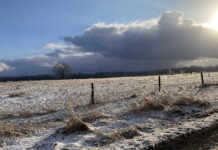It seems the older I get, the longer winter lasts. So, I was thrilled when the vernal equinox arrived last week. The sun has already begun rising a few minutes earlier and setting a few minutes later each day.
My bones are beginning to warm up. However, the calendar does not guarantee blue skies and sunshine. Biological spring is still several weeks away.
As March gives way to April, I look to nature to tell me when spring has truly sprung. Long-bearded tom turkeys gobble, strut, and display to assemble a harem. Young jakes keep their distance.
Carolina wrens have been singing their triple note signature song, “tea-kettle, tea-kettle, tea-kettle,” for weeks. They are usually the first of the songbirds to drop a clutch of eggs.
Eastern bluebirds explore tree cavities and nest boxes. By mid-April, I can usually find complete clutches of four or five sky blue eggs. Robins, chickadees, titmice, white-breasted nuthatches, cardinals, and towhees seem to celebrate in song every warm pleasant morning.
Spring brings out the best in nature. A song sparrow perches atop a red maple on the edge of a field and sings to draw the boundaries of his territory. From the woods, a downy woodpecker drums, and a pileated pounds a large dead tree.
The migrants
And then there are the migrants. A few turkey vultures returned in February; they lilt across the sky searching for aromatic carcasses. A kestrel perches on a snag along a country road. Grackles and red-winged blackbirds return to feeders.
And killdeer appear in yards, parks, and cemeteries. Fortunately, the best is yet to come. Field and chipping sparrows will join the backyard chorus, and robins will return to familiar nests sites. In the latter half of April, the floodgates will open.
House wrens, gnatcatchers, vireos, and warblers will return. Some will linger just a day or two, then move farther north. Others will nest and remain through the summer.
If I’m lucky, I’ll hear a whip-poor-will greet a mid-April moonrise. And hungry nighthawks return to patrol the evening sky like giant feathered bats.
In late April, I look for two of my favorite signs of spring. Wood thrushes are often difficult to see when they return because they skulk in the understory of mature woods, but their sweet, flute-like voice, “EE-o-lay!” is music to my ears.
Late April
I especially enjoy their evening vespers as night falls. The other late April returnees are ruby-throated hummingbirds. I try to have nectar feeders up before they return. That reminds me of another sign of spring — a jug of nectar in the frig (one part table sugar, four parts boiling water, cool, refrigerate).
The website that has monitored the return of ruby-throated hummingbirds from 1996 to 2018 (www.hummingbirds.net) is no longer active, though maps for the last 22 years are still accessible.
Instead, visit JourneyNorth (https://journeynorth.org/) for current updates on the 2019 hummer migration.
By the first week in May, spring migration will be in full swing. Warblers, scarlet tanagers, and Baltimore orioles will brighten treetops, and rose-breasted grosbeaks and indigo buntings will add a splash of color to feeders.
But not all signs of spring wear colorful feathers. Along the edges of country roads, watch for coltsfoot, a bright yellow wildflower that at first suggests a dandelion.
Onion-like ramps turn rich bottomlands into seas of green. Mayapples, jacks-in-the-pulpit, Virginia bluebells, and trillium follow. Listen for wood frogs (they sound like quacking ducks), spring peepers, and trilling American toads.
Leaving the nest
Watch for aquatic turtles basking on emergent rocks and logs along streams and shores of lakes. Litters of gray and fox squirrels leave their nests for the first time. Groundhogs and chipmunks emerge from winter dormancy with only two priorities — food and reproduction.
Hungry bats hunt flying insects in the evening sky. And I haven’t even mentioned butterflies fluttering across open meadows, snakes stretched across warm paved roads in the sunshine, box turtles lumbering along country roads, or tasty morels gracing the forest floor.
Yes, it’s been a long winter, but spring has come to the rescue. Take time to notice and enjoy the kaleidoscope of sensations that make it the most exciting season of the year. And be sure to share those sentiments with your children and grandchildren.













